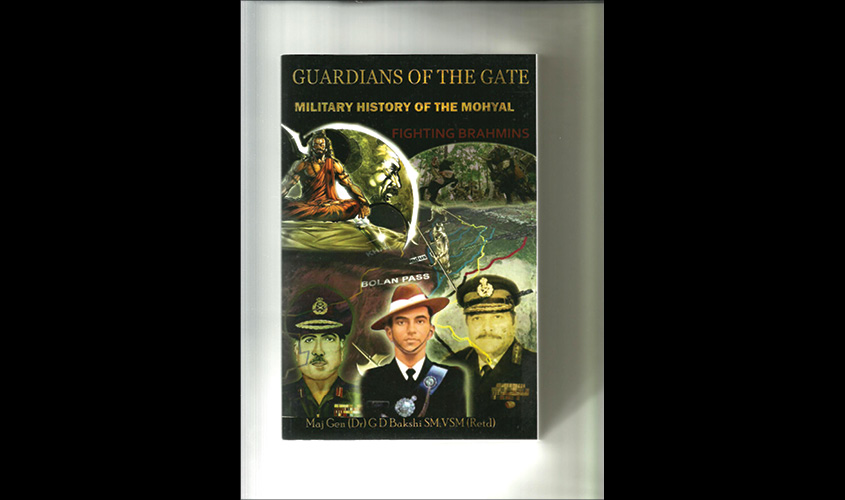Life is indeed stranger than fiction. G.D. Bakshi’s book, Guardians of the Gate: Military History of the Mohyal, Fighting Brahmins is a tour de force of India’s military history through the tales of a remarkable clan of warrior Brahmins. This is the remarkable history of a warrior people who once flourished on the banks of the mighty Sarasvati river and hence fought every single invader who attacked India, right from Alexander to the Arabs, from the Pathans and Turko-Mongols to the Uzbeks. The book throws light on a glorious period of Indian military history, when the Mohyals under King Porus put up a strong fight against Alexander and later, as the Hindu Mohyal kings of Afghanistan, repulsed Arab invasions. This book is by a retired general, who has seen a great deal of combat himself and who has gone ahead in quest of his roots and military lineage to compile this path-breaking history.
The earlier generations of Mohyals took pains to record their history in the form of bardic poems that recorded the wars they fought and the valour their men displayed. The author of this book, a Mohyal himself, has diligently researched ancient and obscure sources to throw some new insights into these badly neglected periods of our military history. One used to wonder why the Arabs were so consumed by the concept of Ghazwa-e-Hind, the apocalyptical battle for the final conquest of India. The world conquering Arab armies had spread through the Middle East, Persia, Central Asia and North Africa and even Spain. The author’s research shows us that for the first time in world history, these all conquering armies from Arabia were checked on the Hindu Kush mountains by the Hindu kings of Afghanistan. These were the Rutbils and Mohyal Brahmin kings of Kandahar and Kabul. They held the Arabs at bay for 300 years. That historical shock lingers in Islamic folklore to this day.
Tracing the history of these unique clans in a chronological order, we learn that the warrior sage Parashuram (considered the sixth incarnation of Vishnu) had militarised the Mohyals in the early epic period. His disciple Dronacharya taught the art of war to the princes of India in the Mahabharata period. From priests these Brahmins metamorphosed into Mohyals, the fighting Brahmins. They were like the Japanese Samurai, the poet warriors, brave and tenacious fighters with a great tradition of soldiering and scholarship. Under Porus they fought the Greek armies of Alexander. After Alexander’s invasion, Chanakya recruited the Mauryan army from this region, which had suffered grievously from the brutal Greek invasion. They subsequently became the Bhumihar Brahmins who later settled in what is today Bihar and Uttar Pradesh and helped unify India under the Mauryan empire. The Tyagis also form part of these clans of fighting Brahmins.
Surprisingly, a Mohyal clan, which had accompanied Alexander’s forces in their retreat, fought in Iraq on the side of the Shias in the famous Karbala war. They are till today called the Hussaini Brahmins. The Mohyals’ greatest feat of arms came when their rulers in Afghanistan stopped the Arab armies on the Hindu Kush. They fought the Arab invasions of Sindh. They fought Mehmood Ghaznavi and Muhammad Ghori, their former cousins who had converted to Islam. When the Mughal empire turned tyrannical under Aurangzeb, they flocked to the banner of the Sikh Gurus to overthrow this evil tyranny. Baba Paraga, Bhai Mati Das and Banda Bairagi were great soldier saints of the Sikh military tradition. They were all Mohyals who played a major role in Indian military revival that took place with the Sikhs and the Marathas. They formed a significant part of the army of Maharaja Ranjit Singh. They were deemed a martial caste by the British and took part in World Wars I and II and played a significant role in the cavalry and artillery of British India.
In 1911, the Mohyals got their history translated into English under the title, The History of the Mohyals, the Militant Brahman Race of India by P.T. Russel Stracey in Lahore. According to these sources, the Saraswat Brahmins with gotras, that is clan names, Datt or Dutt, Vaid, Chhibber, Bali, Mohan, Lau, and Bhimwal are Mohyals.
Soldiers and scholars of history will find this book to be an invaluable document about Indian military history per se—right from the Vedic times to our present era. These fighting Brahmins have maintained their military traditions. Post Independence, for his dauntless valour while fighting Pakistani terrorists in Kashmir Valley, Lt Puneet Datt was posthumously awarded the Ashok Chakra, India’s highest gallantry award in peacetime (equivalent of the Paramvir Chakra). Four Mohyal officers won the Mahavir Chakra and four, the Vir Chakra. Six Mohyals have risen to the rank of Army Commander and equivalent posts in the Army and Air Force and three became Governors of states. Ten became Lieutenant Generals, five became Air Vice Marshals and 15 were Major Generals—all from a minuscule community just about 600,000 strong. They have truly been the guardians of the gates of Hindustan.
Lt Col Anil Bhat, VSM (Retd) is a retired Army officer

